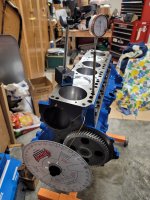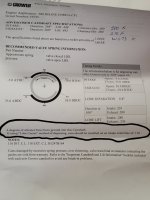That groove is normal.
Is it for oiling purposes? Already got rid of the old cam so I had nothing to reference
That groove is normal.
If the groove lines up with an oil hole then it is for improved oiling.Is it for oiling purposes? Already got rid of the old cam so I had nothing to reference
If the groove lines up with an oil hole then it is for improved oiling.
You are not the first one to question the cam groove.


This degreeing process has been a bit tedious, but I've got some numbers. First my process (following instructions in the degreeing kit), in case I made any errors;
The degree wheel should be 11 on one side and 11 on the other side to be center about TDC so it is 1 degree off center.
Would that make your reading IVO 7.5 or 9.5 if corrected?
The midway point between 7.5 ATDC and 37.5 ABDC is 111.5 ATDC which is close enough.Checking my notes, I had 12° BTDC, 10° ATDC. Mathematically then, that would put IVO at 7.5 and IVC at 37.5, or 2.5 degrees off the cam card? Unless I'm making the wrong jump to a conclusion.
If that would work too, I got checker springs with the degree kit I boughtUse checker springs...?
Looks good. How far down is the lifter plunger from the retaining clip on the solid lifter?
